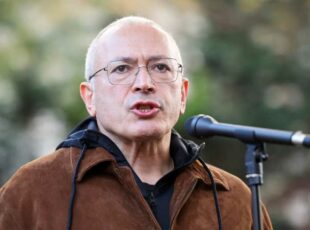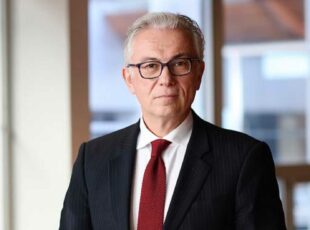Massaging the figures
There is something quite strange about the election results in Saratov Region …
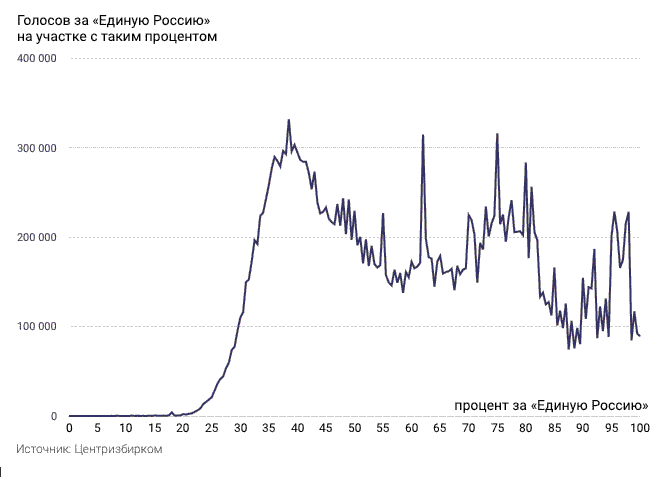
Mikhail Zelensky
The elections to the 7th State Duma ended three days ago, but the number crunchers are still busy processing the vast amount of data churned out. Thanks to the new State Automated Elections System, every one of the 52.6 million votes cast at the almost 97,000 polling stations across the country was counted.
However, one curious anomaly came to light on Wednesday. Before hearing a detailed explanation, try to find it yourself. Below is the nationwide distribution of votes for United Russia. The graph shows the number of votes (Y-axis) cast for the ruling party at polling stations, against the various final results for United Russia (X-axis). We tried removing one region. Can you spot the difference in the two versions of the chart?
Hint: look at the changes in the area of 60%.
X-axis: Percentage for United Russia
Y-axis: Votes for United Russia at polling stations with such percentage

The difference is called “Saratov Region.” The blue line takes account of the region, the red does not. This unique “contribution” by one region to the electoral data set was first noticed by Alexander Kireev, expert on electoral geography.
In Saratov Region, United Russia didn’t just take home a large percentage of the vote (there are regions with far higher results). What’s more striking is that it is the only region where more than 100 polling stations delivered exactly the same result—62.2% to be precise—for the ruling party: tens of thousands of votes were all counted to within a tenth of a percentage point. One in ten ballots was cast at a polling station where United Russia received the magical figure of 62.2%.
To grasp how unusual this is, let’s compare the charts for Saratov Region and Chechnya.
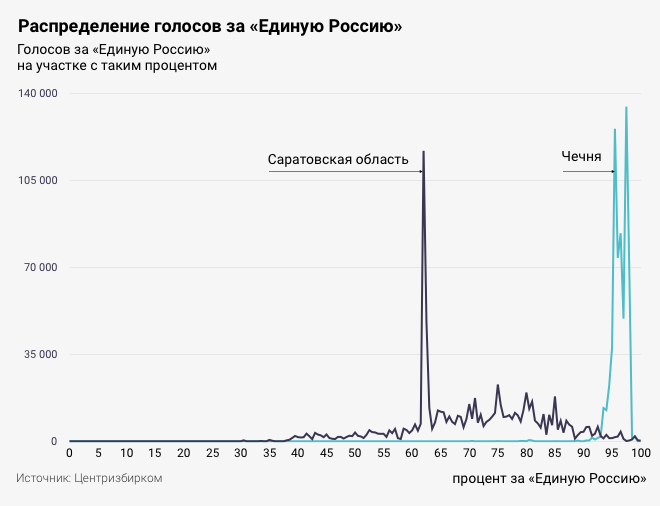
Both regions are clearly very fond of the party of power. But even in Chechnya, where the ruling party picked up more than 90%, there was a greater range of results for United Russia than in Saratov Region. Whereas some polling stations in the Caucasus delivered slightly more than the final 96%, and some slightly less, in Saratov Region there was only one number in town: 62.2%.
The implausibility doesn’t end there. The Central Electoral Commission’s party election data are divided not only by region, but by electoral district, of which there are four in Saratov Region. The first of them (№163) set a regional record for the number of polling stations with the same percentage: 62 electoral commissions (one in six!) served up 62.2%. Nationally, only Dagestan, where 132 stations in one electoral district delivered 100% for United Russia, could beat that.
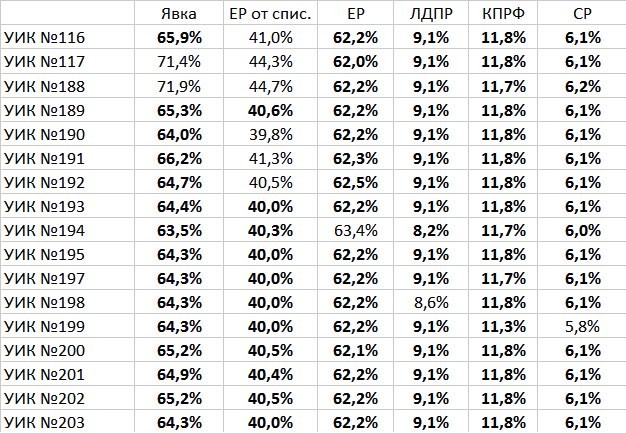
Why 62.2%? Kireev suggests that United Russia’s result was fudged to match 40% of the total number of voters registered (and since not everyone turned out, the end figure was around 60%).
What’s unique about Saratov Region? Practically nothing, except that it’s the birthplace of Vyacheslav Volodin, internal policy chief inside the Presidential Administration, who headed United Russia’s regional list in Saratov Region.
“Our local guy Vyacheslav Volodin set the United Russia agenda. Residential yards and pedestrian zones are being built and repaired. There’s never been anything like it,” said United Russia’s regional branch secretary Oleg Grishchenko after the vote.
Volodin himself chose not to come to Saratov to celebrate the party’s victory, but promised his audience in a teleconference that “work was only just beginning.” Volodin is expected to be the Duma’s new speaker.
United Russia deputy Olga Batalina, the second candidate in the regional list for Saratov Region, told Slon Magazine that she was unaware of anomalies in the party’s results, but promised to look into the matter. Slon Magazine submitted a formal request to both the Central Electoral Commission and United Russia’s election office.
After the original publication of this article (in Russian), Pavel Tochilkin, chairman of the Saratov Electoral Commission, commented on the unusual figures in conversation with RBC. According to Tochilkin, United Russia’s results from polling stations across Saratov Region were not identical. “First, the percentages in the range from 62.16% to 62.24% were rounded to the nearest hundredth; and second, in absolute terms, the numbers range from 384 to 991 voters. These figures point to nothing more than mathematical coincidence,” said the official.
The same argument is put forward in the Central Electoral Commission’s reply to Slon Magazine. The commission also noted that other parties also threw up statistical coincidences in Saratov Region: A Just Russia received 6.11% of the vote at 32 polling stations; the Communist Party 11.78% at 33, and the LDPR 9.10% at 25.
“For your information, the overall percentage of votes for United Russia in Saratov Region came to 68.15%. If the figure of 62.2% you highlighted were higher than the final result, that would indeed be suspicious,” read the response.
However, rounding to a hundredth of a percentage point makes sense only if at least a thousand people turn out. Only then does 0.01% signify a real vote.
This article first appeared in Slon Magazine


